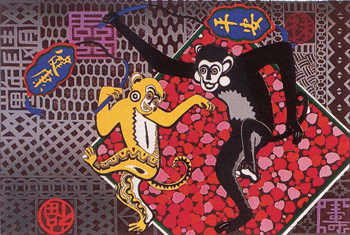![[Metroactive Arts]](/arts/gifs/art468.gif)
[ Arts Index | Silicon Valley | Metroactive Home | Archives ]
Monkey Business
The King Library hosts 'Art of the Zodiac,' a look at how Taiwan artists interpret the year of the monkey
By
THE NEW SHOW AT the King Library in downtown San Jose, "Art of the Zodiac: Celebrating the Year of the Monkey," introduces contemporary Taiwanese arts and crafts to America. The exhibit includes nearly 50 lithographs, woodcarvings, prints and glass works depicting monkeys from Chinese legends.
According to Chinese astrologer Shelly Wu, years of the monkey--of which 2004 is one--are those of "riots, revolutions and the overthrow of rulers. [These years] keep people on their toes. Monkey years spin everyone's concept of 'normal.' Bluffs, tricks, ruses and deceptions abound during monkey years. Those who enjoy risk and novelty thrive. Those who prefer predictability and convention wince." Less-candid Chinese folk legends tell us that monkey years are also those of new inventions, creations and prosperity.
The exhibit begins as you step off the escalator on the second floor. Three anecdotes from China's most popular folk tale, Journey to the West, are inscribed on huge tapestries. Crudely simplified, the 16th-century tale, also called The Monkey King, tells a mythologized version of a Chinese monk's trip to India and features a mutinous monkey who darts off in search of Buddhist sutras to bring back to China.
In the process, the monkey consumes peaches of immortality, revolts against the heavens and accompanies an entourage of disgraced characters through a number of riotous tribulations before finally discovering the scriptures.
In China and Taiwan, where everyone knows this tale, the monkey is ingrained in society as a beloved superhero of rebellion, mischief and tricksterism--someone of great magical talent who can outdo any formidable opponent. As such, he's one of the most adored heroes in all of Chinese literature--like a 400-year-old combo of Bugs Bunny and Superman. There are nine temples in Taiwan alone where the Monkey King is worshipped.
Several pieces in "Art of the Zodiac" take their inspiration from Journey to the West, so it makes sense to begin the exhibit with these tapestries. Most of the remaining works feature the monkey engaged in various endeavors from the story. Kei-chei Chang's colored-ink painting on silk, The Manner of the King, shows the monkey clutching the peach of immortality.
Two other prints--Monkey on a Horse and Monkey Hanging Up a Chop--symbolize promotion in the office and prosperity. Several different pieces are titled Conferred With Nobility, possibly reflecting the monkey's rise to immortality in Journey to the West. Chih-hsin Lin's printing Heavenly Happiness and Supreme Fortune shows the monkey perched upon a rock, contemplating his accomplishments. In a more abstract fashion, Ming-fong Hsu's lacquer painting Playing With the Peach portrays the Monkey's rambunctious, restless nature.
Any Chinese astrology source anywhere will tell you that those born in the year of the monkey are highly likely to become famous or well known, and that they are the rock stars of the zodiac. Many of the works in "Art of the Zodiac" place the monkey in this light, celebrating his own immortality.
In Taiwan, monkey iconography has evolved and made its way to every facet of culture imaginable, from proverbs to totem-pole worship. "Art of the Zodiac" showcases how contemporary Taiwanese artists are exploring these long-established monkey legends through the use of current natural resources for their crafts. Though it's not a big show, the exhibit is a splendid way to ring in what Shelly Wu calls "a year highlighting politicians, diplomats, ambassadors, writers, spokesmen, storytellers, orators, salesmen and confidence games; the riverboat gambler year of the Chinese zodiac--the irrepressible monkey."
[ Silicon Valley | Metroactive Home | Archives ]
Copyright © Metro Publishing Inc. Metroactive is affiliated with the Boulevards Network.
For more information about the San Jose/Silicon Valley area, visit sanjose.com.
![]()

Monkey Dance: Chao-meng Chen's watercolor declares, 'Welcome! Good Luck.'
Art of the Zodiac, presented by the Council for Cultural Affairs, under the Executive Yuan in Taiwan, along with the National Taiwan Craft Research Institute, runs through March 5 at the Dr. Martin Luther King Jr. Library in San Jose.
Send a letter to the editor about this story to letters@metronews.com.
From the February 18-25, 2004 issue of Metro, Silicon Valley's Weekly Newspaper.